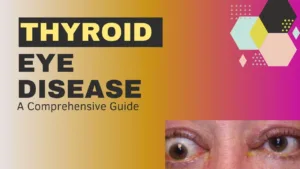Understanding Thyroid Eye Disease: A Comprehensive Guide

Introduction:
Thyroid eye disease, also known as Graves ophthalmopathy or Graves’ orbitopathy, is a condition that affects the eyes and surrounding tissues.
It is commonly associated with an autoimmune thyroid disorder called Graves’ disease. In this detailed blog, we will explore the causes, symptoms, diagnosis, and treatment options for thyroid eye disease.
Causes and Risk Factors of Thyroid eye disease:
Thyroid eye disease occurs when the immune system mistakenly attacks the tissues around the eyes, leading to inflammation and swelling.
It is primarily associated with Graves’ disease, an autoimmune condition characterized by an overactive thyroid gland.
The exact cause of thyroid eye disease is not fully understood, but it is believed to involve a combination of genetic and environmental factors.
Women and smokers are at a higher risk of developing the condition.
Symptoms of Thyroid eye disease:
The symptoms of thyroid eye disease can vary in severity and may include:
Bulging or protruding eyes (exophthalmos)
Puffiness around the eyes, swelling, and Redness,
Irritation of the eyes, Dryness, and grittiness,
Double vision or blurred vision
Sensitivity to light
Eye pain or discomfort, especially when moving the eyes
Difficulty closing the eyelids completely
Changes in the appearance of the eyes, such as eyelid retraction or eyelid lag
Diagnosis of Thyroid eye disease:
Diagnosing thyroid eye disease involves a comprehensive evaluation by an ophthalmologist or an eye specialist.
The diagnosis typically includes:
Medical history: The doctor will inquire about any existing thyroid conditions or other autoimmune disorders.
Physical examination: The doctor will assess the appearance and function of the eyes, including measurements of eye protrusion and assessing eye movements.
Imaging tests: Imaging techniques such as computed tomography (CT) or magnetic resonance imaging (MRI) may be performed to evaluate the structures and tissues around the eyes.
Blood tests: Thyroid function tests and antibodies associated with Graves’ disease may be measured to confirm the connection between thyroid dysfunction and eye symptoms.
Treatment of Thyroid eye disease:
The management of thyroid eye disease aims to alleviate symptoms, preserve vision, and improve the overall appearance of the eyes. The treatment approach may involve:
Medications: Anti-inflammatory medications, such as corticosteroids, may be prescribed to reduce eye inflammation and swelling. In some cases, immunosuppressive medications or biologics may be used to modulate the immune response.
Artificial tears and lubricants: These can provide relief from dryness and irritation of the eyes.
Eyelid care: Proper eyelid hygiene and the use of warm compresses can help manage eyelid retraction and prevent complications such as corneal exposure.
Prism glasses or patching: These can help address double vision or blurred vision.
Surgical interventions: In severe cases or when conservative measures fail to improve symptoms, surgical options may be considered. These may include orbital decompression to reduce eye protrusion, eyelid surgery to correct eyelid position, or strabismus surgery to correct eye alignment.
Lifestyle Modifications:
Certain lifestyle modifications can also help manage thyroid eye disease. These may include:
Smoking cessation: Quitting smoking is essential, as smoking can worsen the severity and progression of the condition.
Adequate nutrition: Consuming a well-balanced diet rich in antioxidants and nutrients may support eye health.
Eye protection: Wearing sunglasses and using protective eyewear in windy or dusty environments can help alleviate eye dryness and irritation.
Conclusion:
Thyroid eye disease is a complex condition that requires a multidisciplinary approach involving endocrinologists, ophthalmologists, and sometimes, oculoplastic surgeons.
Early diagnosis and timely treatment are crucial for managing symptoms, preserving vision, and minimizing long-term complications.
If you suspect you have thyroid eye disease or are experiencing eye-related symptoms in the context of a thyroid disorder, it is essential to consult with healthcare professionals who can provide a comprehensive evaluation and guide you through the appropriate management options.
Also, Visit: Health and Wellness